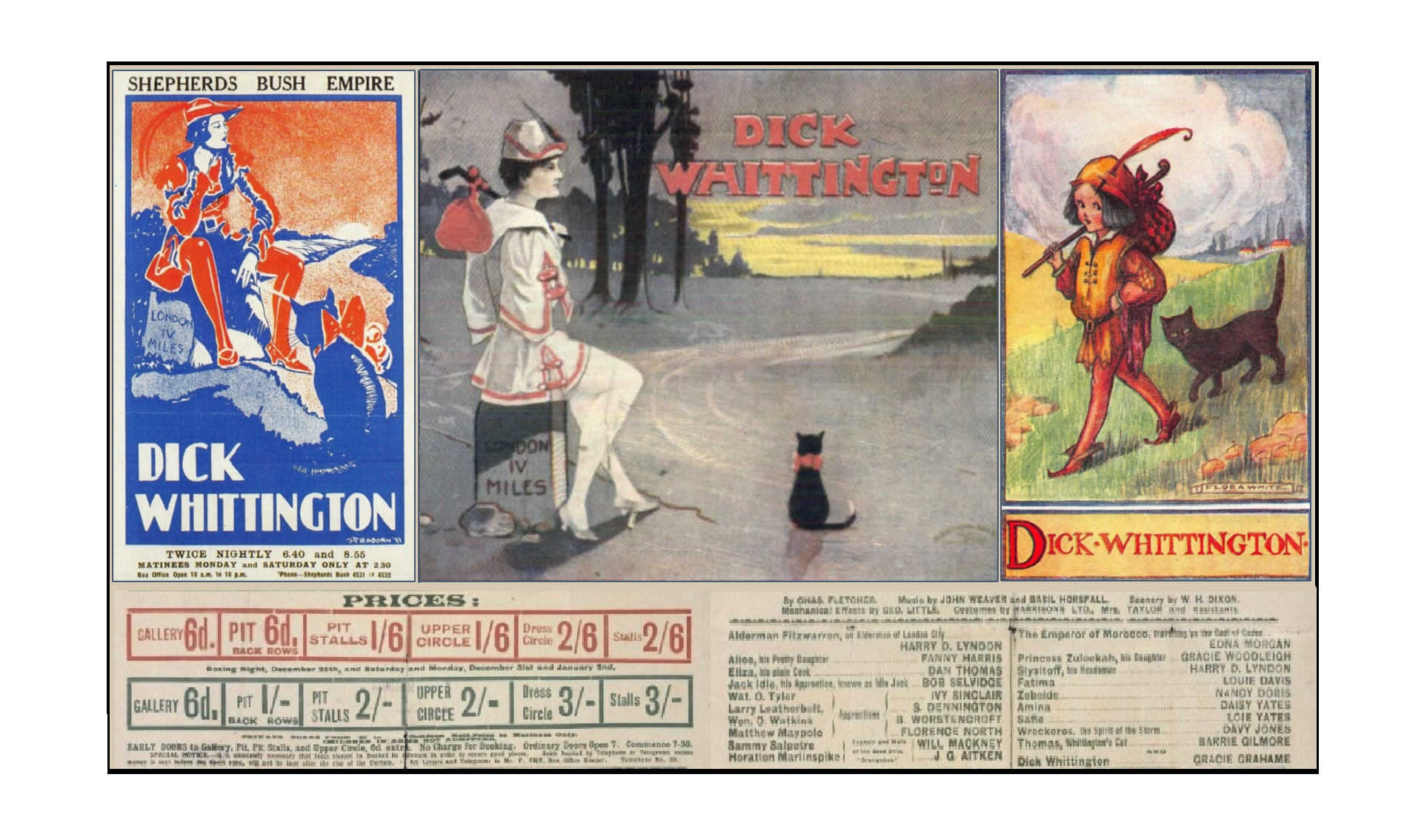
As we are facing serious panto-deprivation this winter, I thought I’d take a look at that perennial Chrimbo favourite and all-round City good-guy, Richard Whittington.
So, what do you want to know?
Oh, no he wasn’t!
Okay, perhaps I’ll stop with the panto audience participation now.
Anyhow, Whittington was born into the Gloucestershire gentry in the 1350s. His father and grandfather were both knights, and his two older brothers were both members of Parliament. Richard, being a youngest son, did not inherit any part of the family estate and instead was sent to learn a trade suitable for the gentry in the City.
I’m afraid not. He was apprenticed to a mercer and married Alice, the daughter of the wealthy Sir Ivo Fitzwaryn, who may have been the mercer in question – sadly, records are incomplete. A mercer is one who trades in cloth and related goods; the Worshipful Company of Mercers was, and arguably remains, the wealthiest and most powerful livery company in the City.
Whittington was a success in business from the outset, possibly due to friends in high places, and well before he reached the age of 30 had opened his own business assisted by 5 apprentices, trading in such luxury materials as silks and damasks. By 1389 he was selling goods to the King, including wedding dresses for two daughters of Henry IV.
So not even a hint of failure here.
Well … the Whittington Stone is certainly on Highgate Hill, N6 – but the first record of a stone marking the spot is hundreds of years after his death, in a location previously occupied by a cross of St. Anthony, where traditionally alms and charitable gifts were left. It is possible that the Great Bell at Bow (the tenor bell at St Mary-le-Bow, Cheapside) could have been heard there, as reputedly it could be heard on Hackney Marshes, a similar distance from Cheapside, but there’s no evidence that Whittington ‘turned again’ here, or at any other spot for that matter.
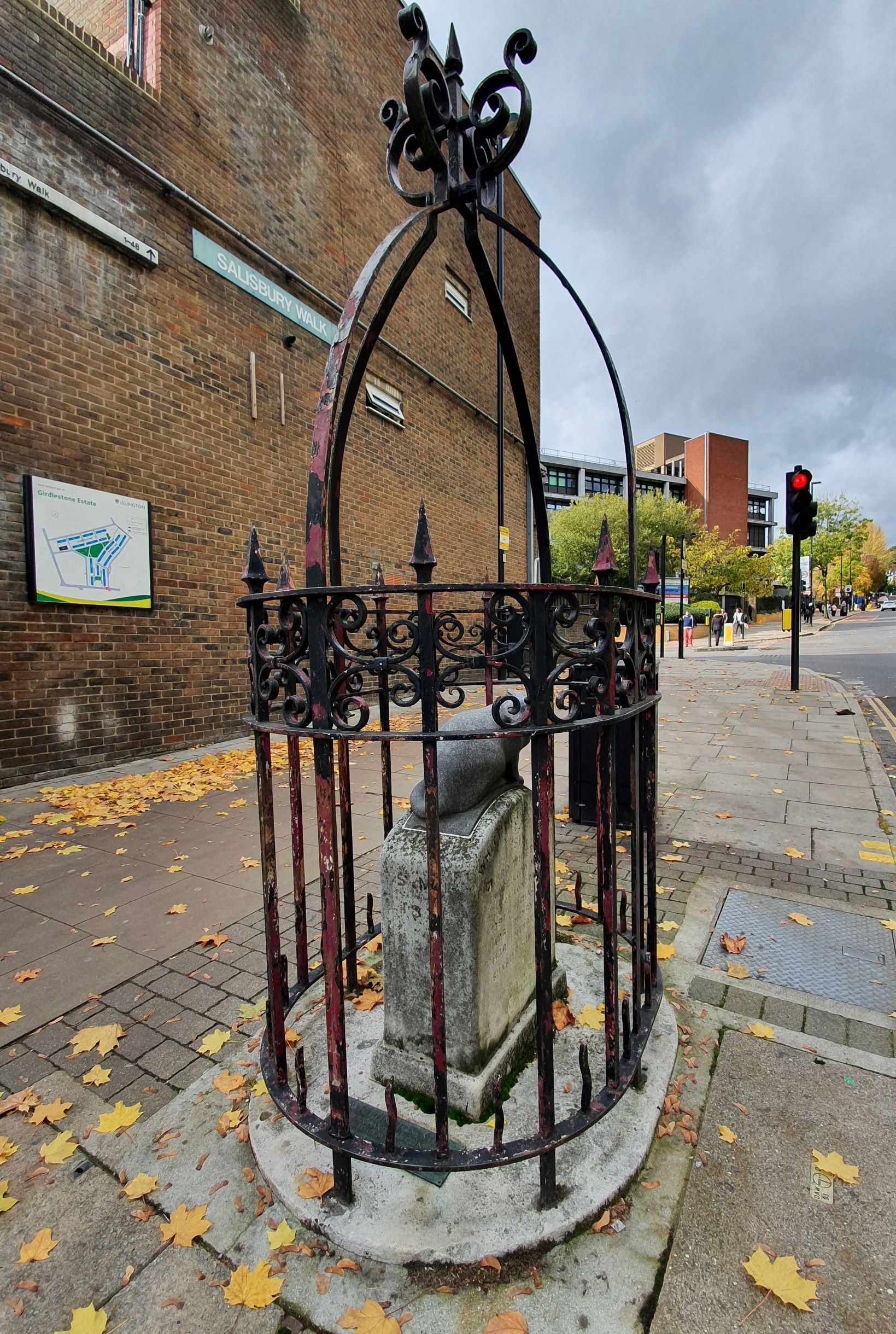
→ To be brutally honest, there’s not a lot right about the 1821 Whittington Stone. The entire premise is fiction, one side is completely eroded and unreadable, the cat – turning its head towards London as if hearing Bow bells – looks rather 20th century (as indeed it is, being added in 1964), and Whittington has erroneously been given a knighthood – contrary to legend, there is no evidence he was knighted.
This romantic farrago has been listed grade II by Historic England since 1972.
There is no evidence that he did, though to be absolutely fair, in 1949 builders did discover a mummified cat – with the longer legs typical of felines in the medieval period – in what might have been his grave. Whittington died in March 1423 and was buried in the church of St. Michael Paternoster Royal, to which he had donated large sums during his lifetime. The church was destroyed in the Great Fire and rebuilt by Wren, with a steeple by Hawksmoor. It was badly damaged in the Blitz and only rebuilt again in 1968. After all of that action, the tomb is – unsurprisingly – lost. The mummified cat found during a search for the tomb’s location likely dated to the Wren rebuilding.
The situation is muddied somewhat by a painting – now also lost – showing a mercer in full livery (uniform) with a black and white cat, labelled ‘R. Whittington’ and dated 1536. Attwood (1988) insists this must be Robert Whittington (c.1480-c.1520) a well-known grammarian, but perhaps it represents the start of the cat myth.
Sorry to disillusion you again, but no. Officially, he was mayor four times. Initially, he was imposed on the City by King Richard II on the death of his predecessor Adam Bamme in 1397, and this part-year counts as his first term of office. He won the next scheduled mayoral election, and was elected again in 1406 and 1419. So, admittedly he was only elected three times.
His climb up the greasy pole is the traditional route used to this day if you want to be Lord Mayor:
He was also a Master of the Mercers’ Company three times, and Mayor of the Staple of Westminster and Calais and Collector of Wool Subsidies 1401-3 and 1407-10. This was at a time when Calais was still an English possession.
Folk tales focusing on the venturing (sale) or adventures of a cat overseas are the starting point for what became the Dick Whittington pantomime; these were known in Russia, Persia and elsewhere and may have had a Buddhist origin.
Now, quite why Whittington was added to this to create what is an extremely English tale is unclear; perhaps it was because he seems to have been one of the few genuinely good guys of medieval times. He was successful and had no children and – after 1409 – was a widower; with no dependents he could donate a lot of money to good causes during his lifetime and in his will; additionally his mayoral administration did things that benefited the general population of the City. Perhaps people treasured his memory and saw him as setting a good example for children.
The Dick Whittington pantomime may have been in existence in some form by 1590 when a popular engraving of Whittington, previously showing his hand resting on a skull, was amended to show it resting on a cat. A dramatic version (playscript) was licensed in February 1604. A ballad was licensed for publication later in the same year. Sadly, neither have survived; the earliest extant version is a printed ballad in the collection of the British Museum, dated 1641.
Not much. Here’s a brief plot summary; I’ve put the facts which are broadly true in bold italics:
Poor Dick Whittington travels to London to seek his fortune, as he believes the streets are paved with gold. A fairy introduces him to a cat, so he has a friend. He meets Alice Fitzwarren, daughter of Alderman Fitzwarren, a merchant. Alice offers Dick work in their shop. The pair fall in love.
Dick must guard the shop’s safe overnight. He settles down to keep watch. Enter King Rat, who detests both Dick and the cat. He steals the money from the safe, but then deliberately puts it in Dick’s pocket. When the robbery is discovered, the money is found on Dick. He is dismissed, must leave London and never see Alice again.
Dick and the cat turn at Highgate Hill to take one last look at London. The fairy intervenes; Bow bells can be heard, and seem to say ‘Turn again Whittington, Lord Mayor of London.’ If he returns and faces his troubles, he can be Lord Mayor three times. He turns back.
At London docks, the Alderman’s ship is ready to sail. Dick and the cat stow away, seeking fame and fortune. The ship sinks in a storm, and both are washed ashore in Morocco. Here King Rat and his cronies are causing chaos – cats are unknown in Morocco. The King states that whoever rids him of the rats will get half his treasure and the hand of his daughter in marriage.
The cat’s arrival causes great excitement. Dick tells the King that the cat will kill the rats, which it does. Dick is given the treasure, but declines the hand of the princess as he loves Alice. He returns to London a wealthy man. The Alderman allows Dick and Alice to marry. Dick becomes Lord Mayor.
Good news at last. He did, and there is. ‘Are’ rather – as there are two.
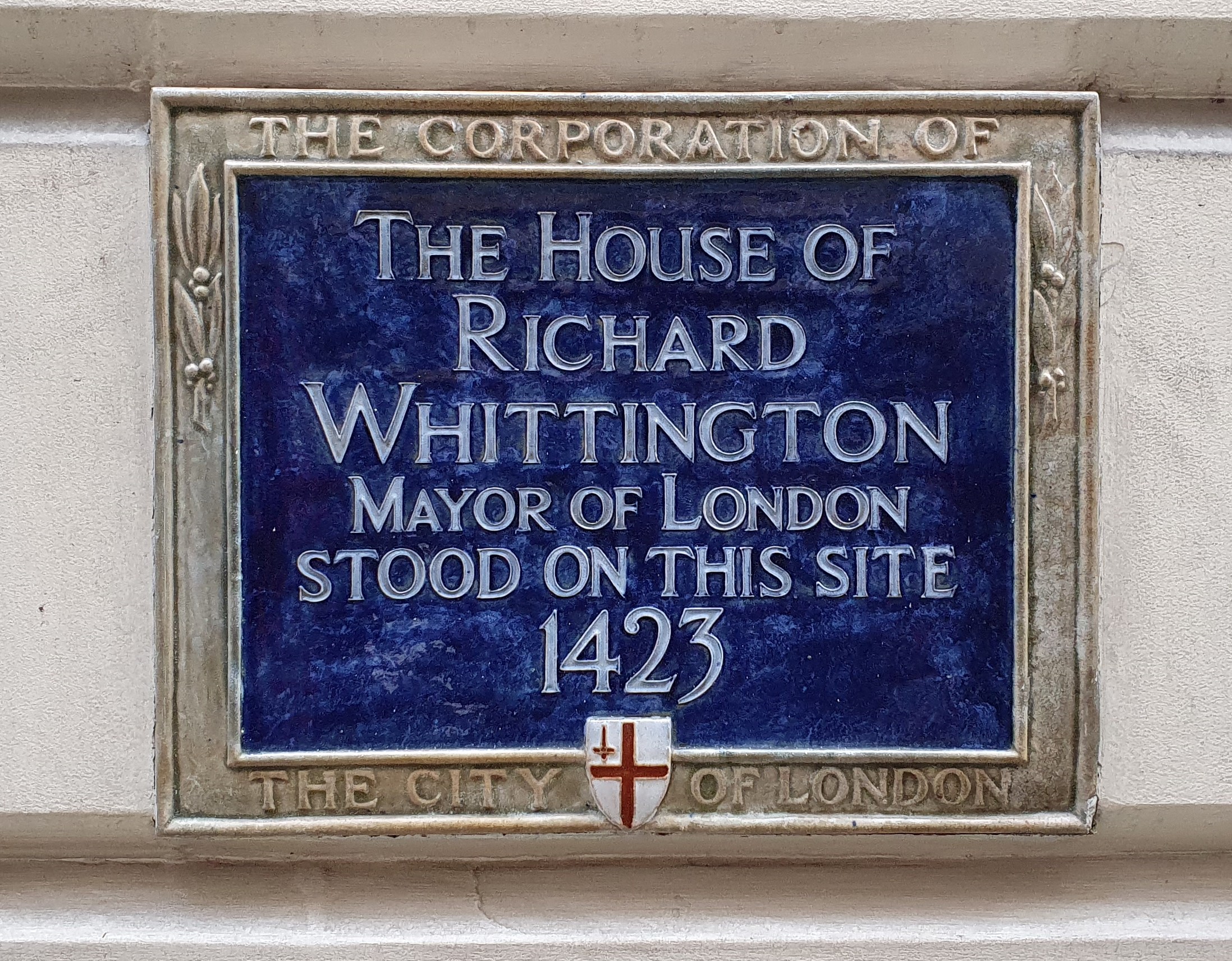
Although he probably lived in several City locations over the years, this plaque adorns a mid-19th century Italianate building called Whittington House, next to the church of St Michael Paternoster Royal, on College Hill.
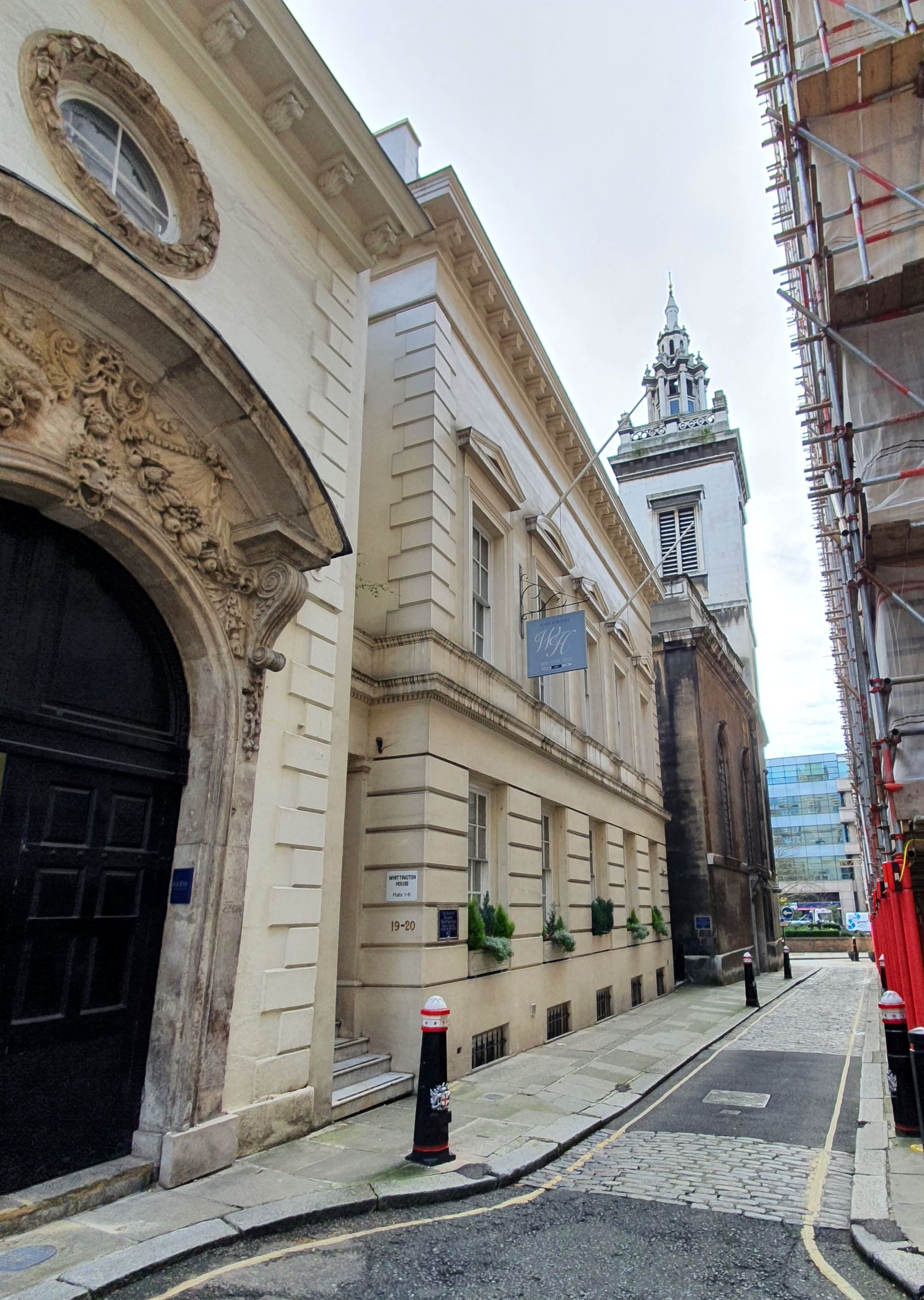
Whittington House (centre) covers the site of Whittington’s last home and the almshouses founded by a bequest in his will. After the departure of the almshouses to Highgate Hill c.1820, the current building was constructed as the new home of the Mercers’ School. Sadly, after 500 years of history, this school closed in 1959.
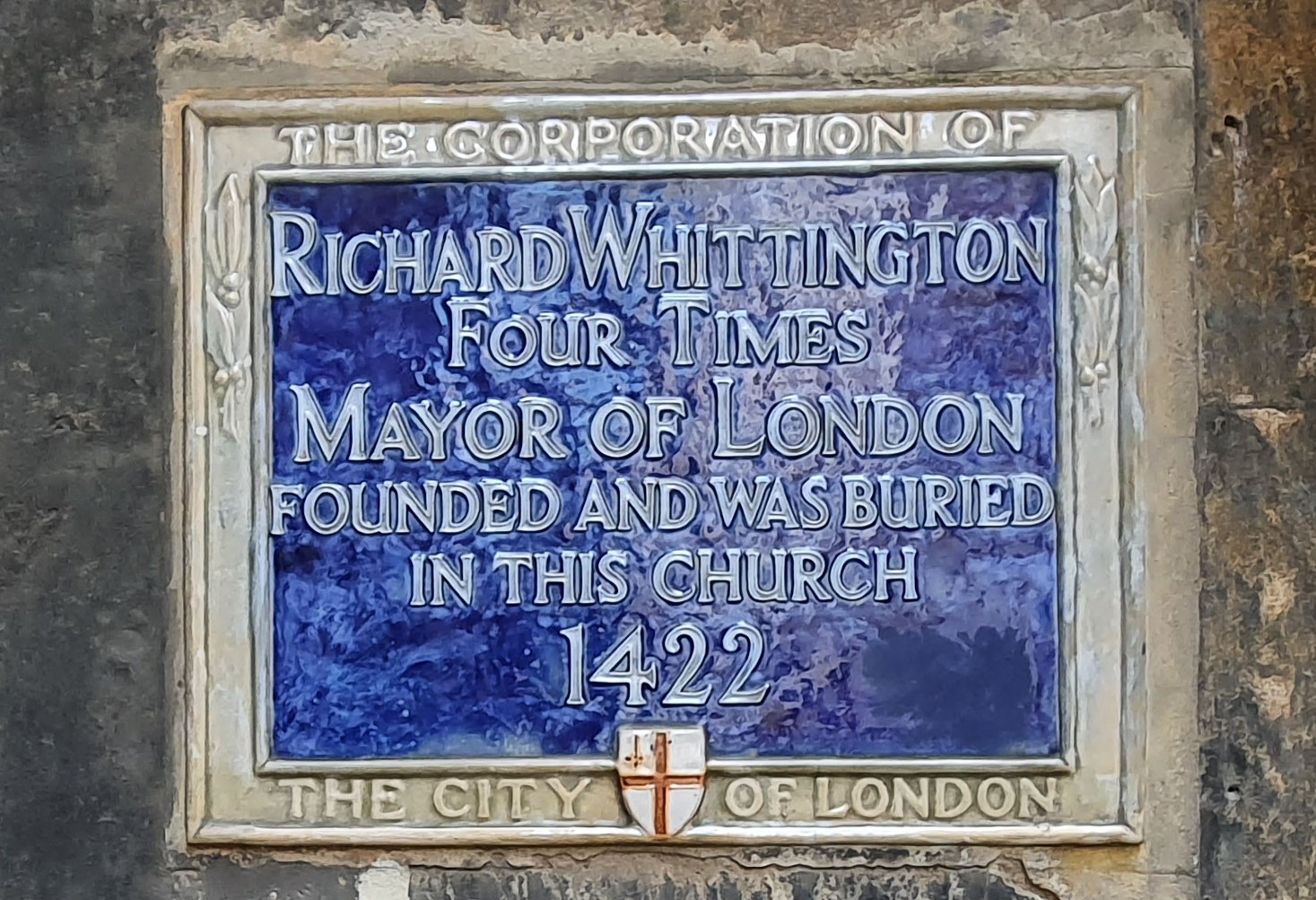
For good measure, Whittington’s connection with St. Michael Paternoster Royal is commemorated by another plaque. It must be the only location where the same person appears on two plaques within metres of one another.
There was the 1397 rising of the ‘Lords Appellant’ – a group of disgruntled nobles – resulted in King Richard II ordering him to raise a militia to arrest the Duke of Gloucester. To be honest I’m not sure any nobles were ever truly gruntled in those days.
He issued proclamations against the adulteration of wine in 1419, and did much to stop the selling of poor quality or overpriced beer – a vital resource given the contamination of water. As part of this campaign ‘ale conners’ were appointed to each ward of the City to test the quality of ale. Reputedly the conner would wear leather breeches and when testing ale would order two pints, pouring one on a bench on which he then sat drinking the second. If, after finishing his pint, he had stuck to the bench then the ale was of good quality. Do not try this at home unless you want to be thought of as being a bit weird.
He also lent vast sums to the monarch – lending on 58 separate occasions between 1388 and 1422. This included £1,000 for Richard II, which could have proved disastrous given the King was deposed still owing the money in 1399 – yet the money was inexplicably repaid by authorisation of the deposed king in 1400.
His role amounted almost to official banker to King Henry V, reputedly organising a loan of £60,000 for the King’s wars in France. Legend has it that Whittington, at a banquet held in honour of Henry at the Guildhall, threw on the fire the records of £30,000 of war loans the City had provided him, in gratitude for a victory. Another version of the story has it taking place outside London at a meeting between the King and City officials.
Among other things, he …
And in 1419, no doubt to everyone’s relief, he provided the first ever public convenience in the City, in Vintry ward near what is now the north end of Southwark Bridge. In an extraordinary move that puts modern-day theatres to shame – probably why it doesn’t feature in the panto – there were 60 places for men and the same number for women. As it was next to the Thames it was ‘purged’ at high tide, so a visit to the public privy was best timed for the start of ebb tide. Despite this purging, I can’t see that the five apartments for pensioners he had built above it would have been particularly fragrant. It was destroyed in the Great Fire 247 years later.
Among others …
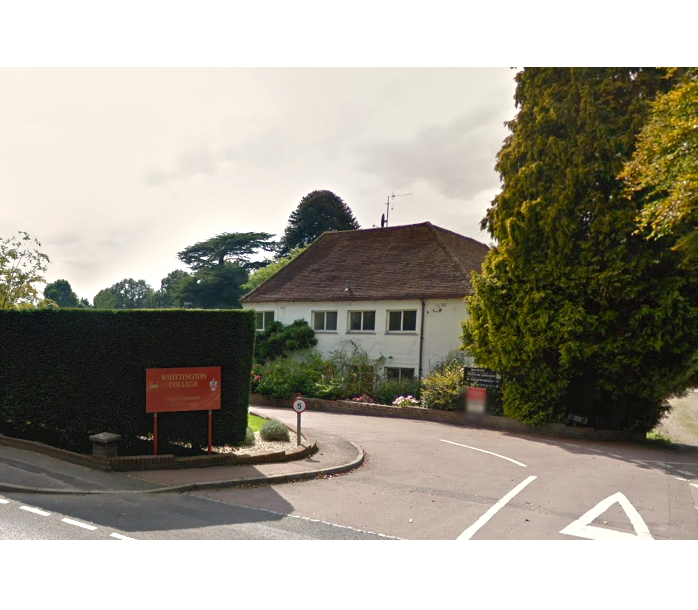
← The entrance to the current Whittington College, the almshouses originally founded by Richard Whittington in his will of 1423, now in Felbridge, West Sussex.
Yes. Leaving aside the Whittington Stone, there are several – mostly in places you’d expect to find them given his life.
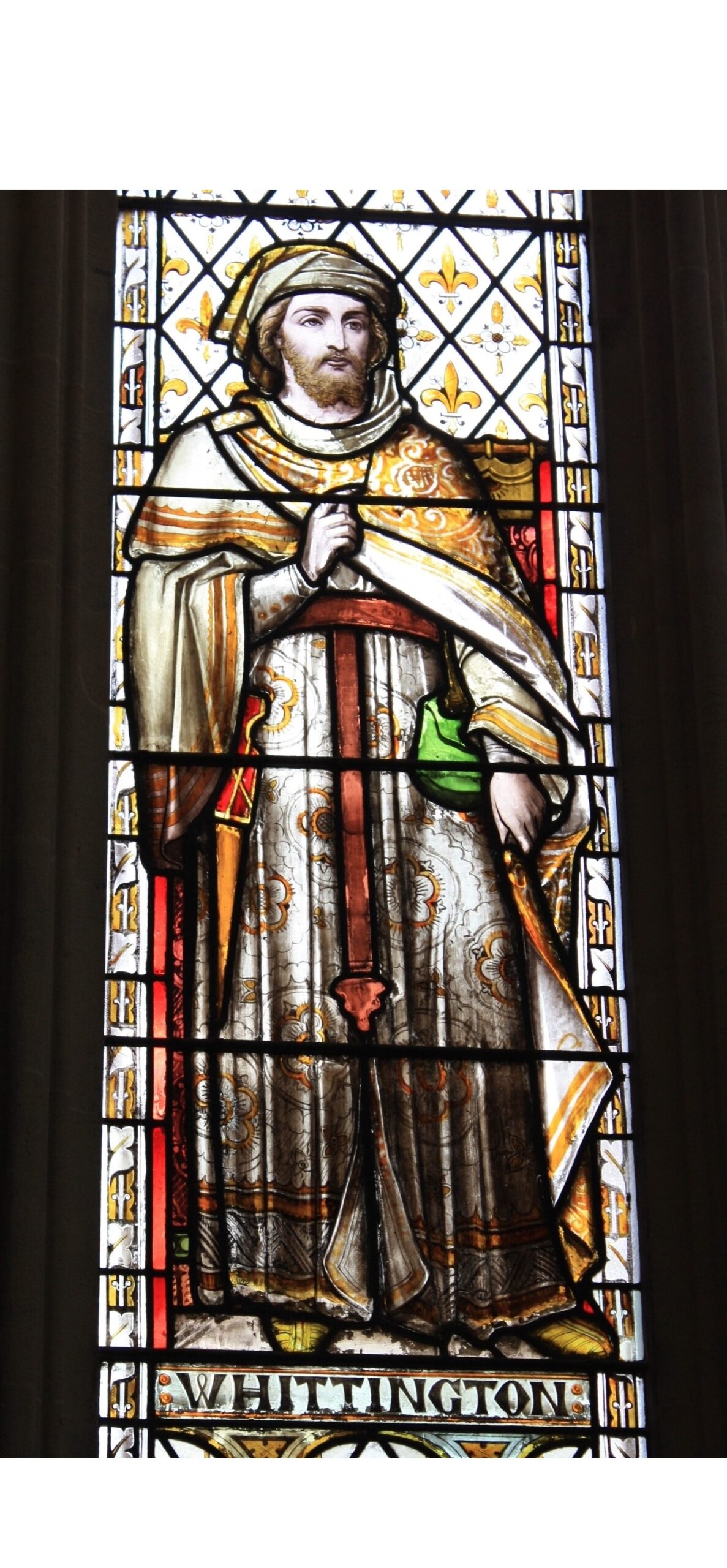
This stained glass window featuring Whittington is in the Guildhall, the seat of City authority since the early 15th century. Note the absence of a cat, which is unsurprising given this is the City of London celebrating the real man and his real achievements, not fictional felines that can talk.
There’s also a stained glass window dating to 1913 in the north side of the nave of Westminster Abbey. He is a minor character in the window, bizarrely depicted wearing ancient Roman garb and complete with a ginger cat. He’s there because he was the administrator and receiver of revenues for the building of the nave area of the Abbey 1413-1422, and also gave money himself towards the work.
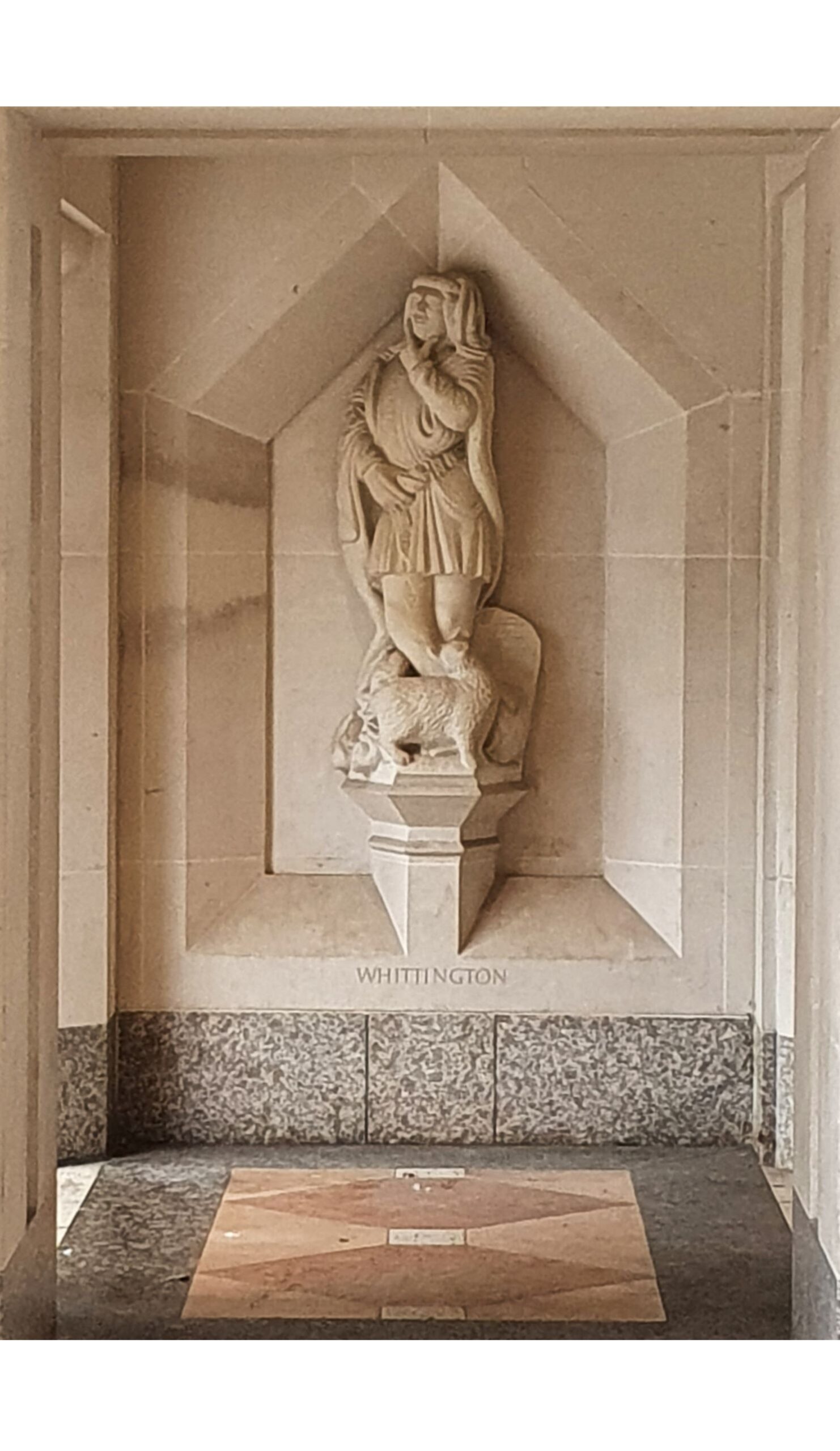
This modern depiction is a stone’s throw from the Guildhall, in the front ambulatory of the Guildhall Art Gallery, a building completed in 1999. Another work featuring a feline, it was apparently designed to appeal to children.
There is a more modern window in the 1968 rebuilt interior of St Michael Paternoster Royal, again replete with cat and this time with a knapsack, just to pile on the cliches. Surely Whittington deserves a more realistic depiction in the church he lavished so much time and money on.
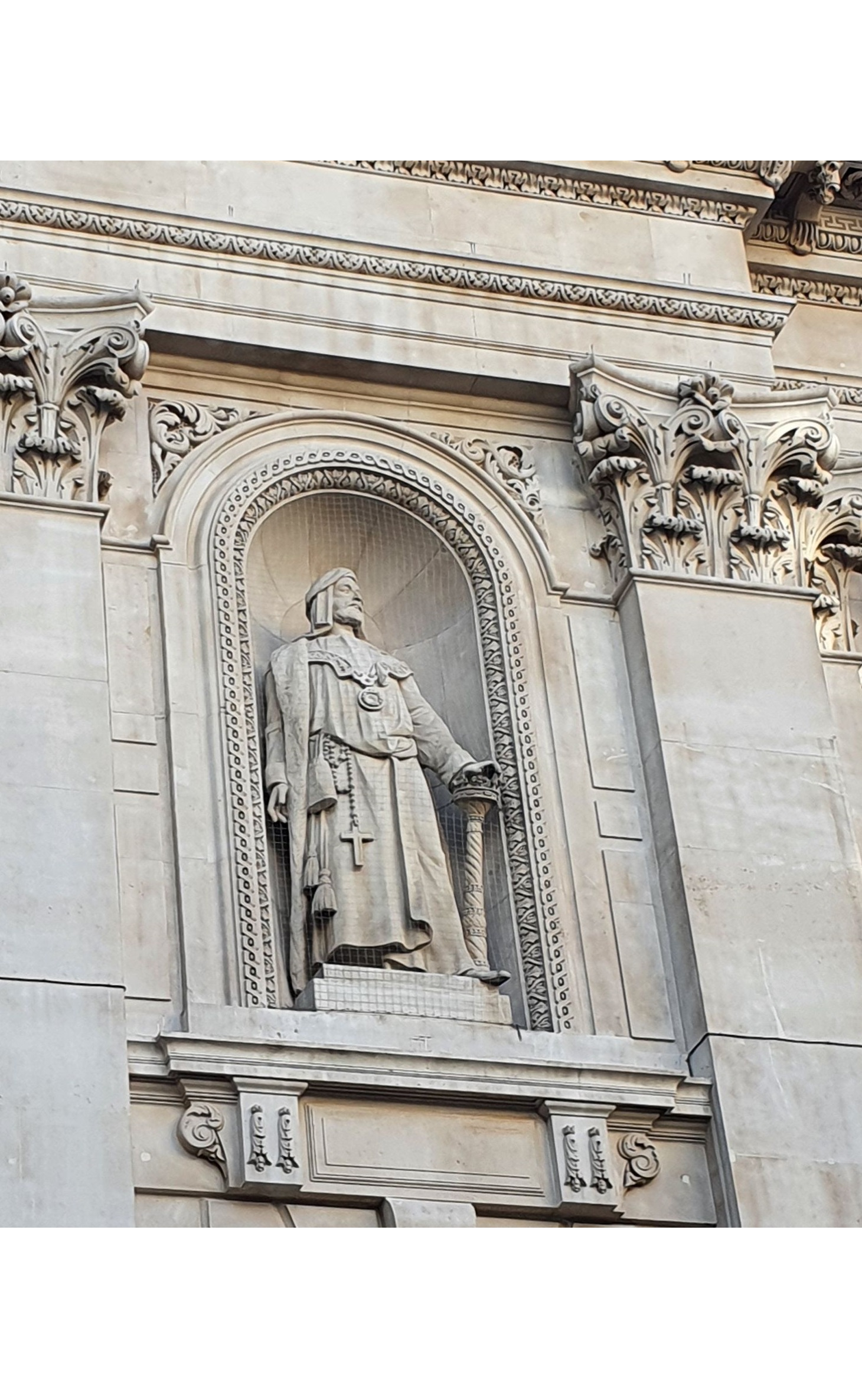
Returning to a more dignified depiction, the current Royal Exchange of 1844 features a statue of Whittington on the exterior facing Threadneedle Street and the Bank of England, the work of John Carew.
Nearest Stations:
Selected Bibliography:
Credits: